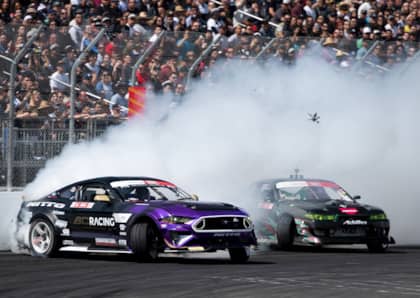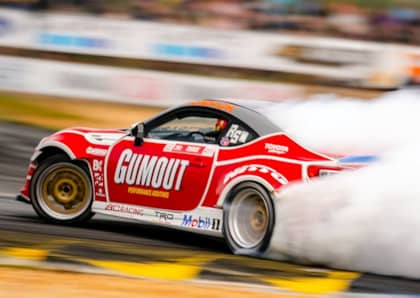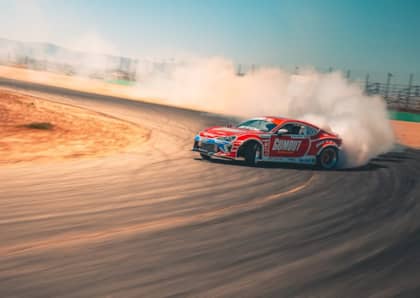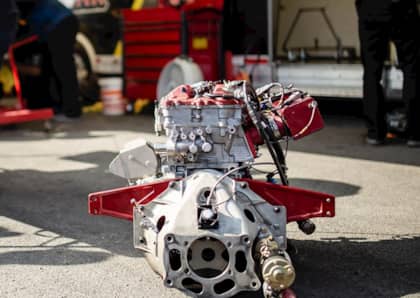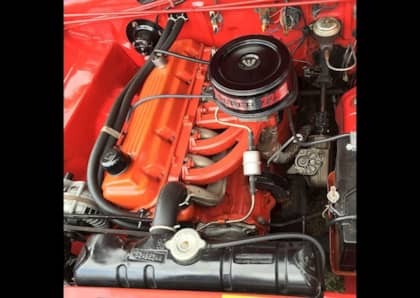6 Mods That Improve Grip in a Drift Car
Drifting is largely regarded as one of the most fun motorsports you can participate in with a real-wheel drive car. When people initially watch drifting for the first time, especially high level competitive drifting, the assumption is often that the cars are setup to be extremely loose in order to make it easy to spin the tires. The reality is that competitive drift cars are actually set up to be extremely grippy, to allow the driver to control the car both with forward grip to maximize speed and side grip to maximize the precision of the drift. There are several different ways to dial in grip in a drift car, follow along as we explore a handful of methods.
Side Bite vs. Forward Bite
First, a little discussion about grip direction—drifting is a unique motorsport in that grip levels are dialed in for two different directions to maximize the efficiency of each chassis. In many ways, maximizing grip in one direction will cause a car to lose grip in the other. Forward bite is the traction that the car will feel on throttle in the direction that the rear tires are facing, and is felt by the driver in the back and butt while accelerating. Side bite is the traction that the car will feel in the direction that the front tires are pointed, both on and off the throttle. This grip is felt by the driver in the hips as the car slides sideways.

Too little forward bite and the car will spin the tires, which will lead to slow acceleration and slow transitions. Too much forward bite will lead to the car driving towards the inside of a turn when on throttle. Too little side bite can cause the car to follow the front tires while in drift and off throttle, which causes the car to take a wider angle around a turn and appear to ‘wash out.’ There’s a very precise balance between forward bite and side bite, and each car and chassis will have different settings to find the balance between the two based on wheelbase, weight, horsepower and driver preference.
1. Spring Rates and Shock Dampening
When road racing and traditional motorsport drivers first started to drift, the prevailing school of thought was to use very high spring rates and stiff shock dampening to try and force the rear of the car to transfer weight through transitions to the rear tires. After more than 15 years of professional drifting in the United States and a lot of testing and tuning, most competitive drift cars have fairly soft rear suspension set up to help the car transfer the weight and momentum more progressively to the rear tires. If the rear suspension is too soft, then the car will ride on the bump stops, which won’t effectively transfer the power to the rear wheels and can quickly blow out the suspension.

Generally speaking, softer springs will create more forward and side grip, but the dampening of the shock will need to be matched for the rate and amount of travel that the spring supports. Stiffer suspension has its’ advantages, as it is much easier to break traction and initiate a drift with a stiffer setup, which is part of why this was the prevailing train of thought early in the life of the motorsport. Many of the top suspension companies like BC Racing, Feal, and ISR Performance have a general guide of what spring rates and shocks will work together well based on the chassis, weight, and power levels of a driver, so feel free to speak with a technical representative from the suspension company you choose to get a general baseline of where to start. The correct spring rates and shock dampening rates will be largely based on the weight of each car, the suspension length, and the driving style of each driver, so there’s no single formula to success.
2. Shock Length
In discussing the different suspension setups with various drivers and suspension experts, shock length was one of the variables that wasn't expected to have as much of an effect on the grip levels of a drift car as it does. At a quick glance, the Ford Mustang RTR team of Chelsea Denofa and Vaughn Gittin Jr. have much softer suspension in the rear of their vehicles, while Ryan Tuerck’s Toyota GT86 looks to be much stiffer.

This visual effect is partially due to the longer wheelbase of the Mustangs (107”), as well as the longer shock length on the Mustang compared to the 101” wheelbase and shorter shock on the Toyota GT86. Many street cars run shorter length coilovers and springs to create a lower, more sleek appearance, but this can compromise the amount of grip available when the car is drifting.
3. Alignment Settings
As discussed in our previous drifting modifications article, alignment settings are a crucial part of a drift car. Toe settings, camber, and caster are all important elements to getting the proper weight transfer and grip in a drift car.

On the Formula Drift circuit, teams will see a mix of high banked tracks like Wall Speedway, high speed and but relatively flat banked tracks like Evergreen Speedway, and unbanked courses that are based on road courses like Road Atlanta and the most recent round at World Wide Technology Raceway in St. Louis. Each course will have very different alignment settings for each car, so again, there’s no simple way to suggest alignment settings without knowing the car details or track that is being used for drifting. In general, many drift cars will run a bit of toe out in the front to help with self-steering, and a bit of toe-in in the rear to help with both forward and side bite. Suspension style matters as double wishbone suspension will react differently than a 4-link setup, so talk to teams with cars that run a similar chassis and suspension design as you to help understand what type of suspension settings each chassis prefers for stability and grip.
4. Sway Bars
Sway bars are one of the more drastic differences when comparing traditional road racing setups to drifting setups. On a traditional road-racing car, many drivers prefer a much larger rear sway bar and a smaller front sway bar to help with turn-in and cornering. In drifting, the prevailing thought is that a larger front sway bar than the rear bar.

The rear sway bar is mostly used to help control side bite, and a stiffer car will actually reduce the grip, which makes it easier to initiate and maintain a drift but can lead to a less-predictable transition. Conversely, a softer rear sway bar will allow for more side bite and more predictable transitions, but make it a bit harder to initiate. Front sway bars are largely used to control steering feel, and one of the biggest concerns with adjusting the front sway bar is ensuring proper clearances with all the other front suspension arms. Some drivers even prefer to remove the front sway bar completely and control the movement of the car through spring and shock rates, but again, each driver and chassis will have a different opinion of what works best for each track.
5. Tire Compound and Sizing
Since tires are the point of contact between the car and the ground, they are the most important component to get right. Drivers who are new to drifting often prefer harder compound tires in smaller sizes due to affordability and durability, but competitive drivers will look towards softer compounds and wider sizes.

In Formula Drift, tire width is regulated based on the weight of each car. As an example, a car weight between 2,900 pounds and 2,999 pounds is allowed a tire up to 280mm wide as measured on the ground. Both the weight and the tire size are measured with the driver in the car. For cars weighing 3,200 pounds to 3,299 pounds, they are allowed to run a tire up to 310mm wide. In the Pro 2 class, all cars must weigh a minimum of 2,900 pounds and are limited to a tire width of no more than 260mm as measured on the ground. Other drift organizations outside of the US have different requirements on allowed tire compounds and width restrictions, with some series like D1 Grand Prix in Japan allowing for full race slicks and aren’t as strict with weight regulations. Tire companies are always evolving the compounds that are available to drivers—earlier this year we saw the launch of the Nitto NT555 G2 tire that pro drivers are raving about.
6. Tire Pressure and Temperature
Tire pressure is one of the easiest settings to control but often one that is forgotten. Reducing the tire pressure will lead to a larger contact patch with the pavement, which leads to more grip. Related to tire compound, some compounds respond better to lower tire pressures than others, so work with a knowledgeable tire supplier who can advise which pressure is preferred for the tires you are using.

Also keep in mind that pressure increases as the tire heats up, which happens either from a burnout or over the course of a run. Be sure to check pressure both prior to a burnout, after a burnout and after a run in testing to understand how the pressures change based on the track surface, length of run and speeds that are being drifted. Most top competitive drivers aim to hit their ideal temperatures after a 10 to 15 second burnout or skid session, and will try to time their tire warmup appropriately to optimize the tire pressure. At ProAm and lower levels of drifting competition, this is less important, but still something to watch.

Looking for more drifting content? Check out some other stories related to Formula Drift on DrivingLine.com!




